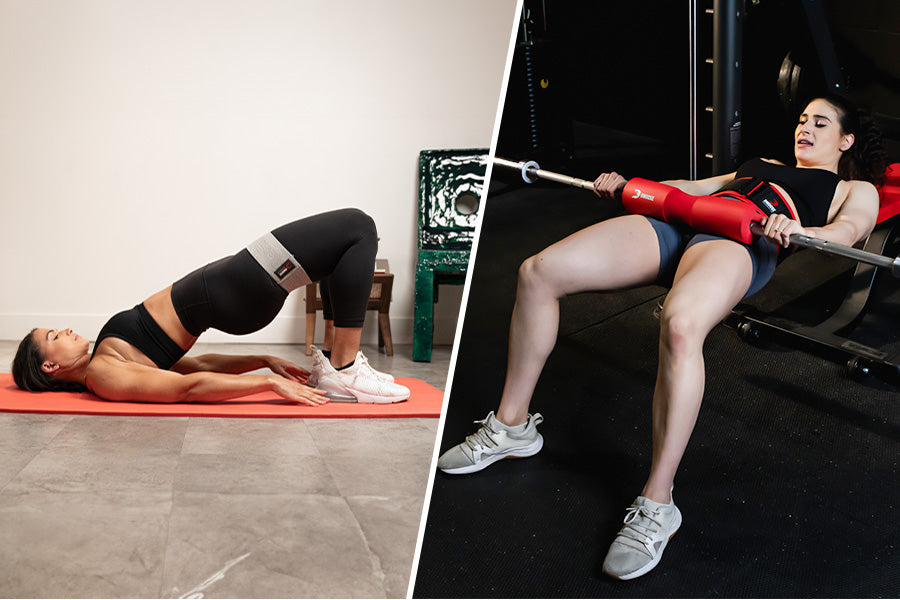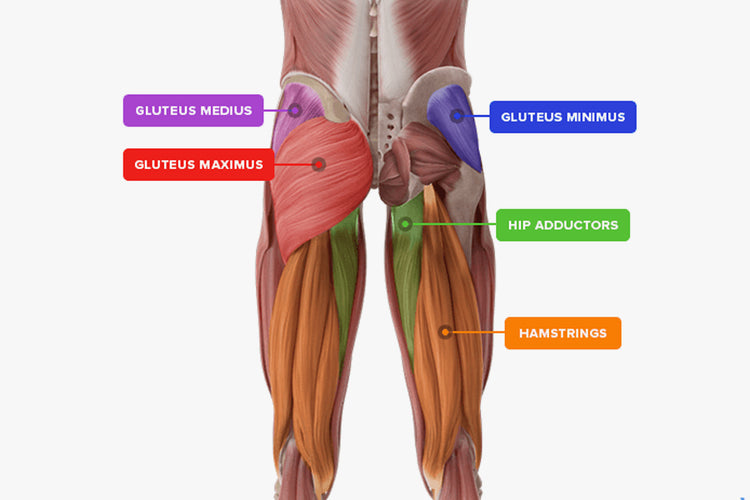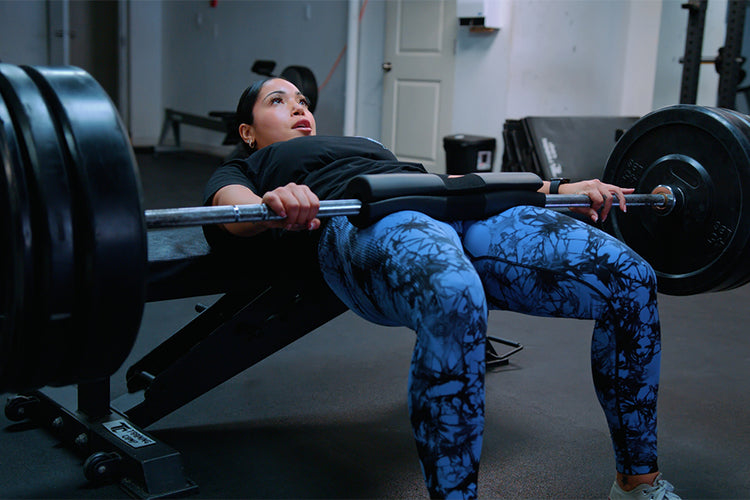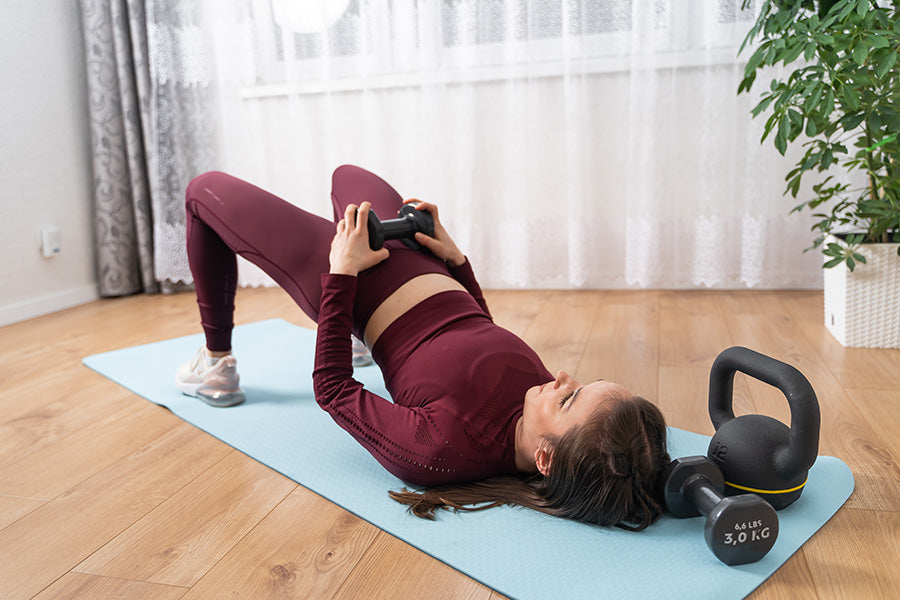Have you tried all the glute exercises but could not achieve the results you want?
The ultimate solution is the Kas Glute Bridge!
What is the kas glute bridge, who introduced it, how fast can you achieve results with this, and what is the right way to do this workout?
Here is a detailed guide. By the end of it, you will have all the guidance to achieve the peach booty shape.
“Kas” Glute Bridge_The King of All Booty Exercises
Recently introduced by and named after the coach Kassem Hanson, this glute bridge is going to help you achieve the booty of your dreams.
It's one of the most effective moves for strengthening glutes and getting them into tip-top shape.
Remember, the Kas bridge is a more advanced variation of the glute bridge that increases the activation of the glutes.
It targets the glutes in the most fantastic way and offers you that chiseled look you've been working so hard for.
Ready to give it a try? Here's how!
How to Do the Kas Glute Bridge
Who needs artificial enhancements when you can build your glute muscles?
Before performing the Kas glute bridge, you must know how to do it correctly. Here are some steps you should follow:
The correct way to do Kas Glute Bridge to Avoid Injuries:
- Sit on the mat next to a loaded barbell, positioning your mid-back against the edge of a bench.
- Place your feet hip-width apart and slightly turned out for comfort.
- Add a barbell pad to your pelvis for stability.
- Roll the barbell onto the crease of your hips.
- Raise your hips along with weight towards the ceiling, keeping your back straight.
- Now, fully extend your hips and squeeze your glutes.
- Pause briefly, and slowly lower your hips before repeating the move.
One thing you should know here is that the Kas Glute bridge is often confused with another workout, “Hip Thrusts.”
However, these are different. Let’s find the difference between to avoid confusion in the future:
Hip Thrusts Vs. Kas Glute Bridge

At first look, they seem quite the same, but both of them have some differences. Based on that, you can decide which one to prefer according to your body type and goal:
|
Aspects |
Hip Thrusts |
Kas Glute Bridge |
|
Targeted Muscles |
Glutes, Hamstrings, Quads |
Glutes |
|
Difficulty Level (depends on weight) |
Intermediate to Advanced |
Beginner to Intermediate |
|
Movement |
Larger motion range |
Glute focused movement |
|
Training Type |
Muscle Building |
Strength training |
|
Ideal For |
Advanced Level for Building Strength |
Beginners working on glute activation |
Related Article: The Ultimate Guide to Building Bigger and Stronger Glute Muscles
Hip Thrust VS Kas Glute Bridge Muscles Worked

Here we will give you a more in-depth comparison between both:
The range of motion in a Kas glute bridge is shorter than in a hip thrust, so you'll use your butt muscles, especially the gluteus maximus, to lift the barbell and extend your hips.
These glute bridges with weight help build strong glute muscles, which, according to ACE, are needed to stabilize your pelvis and ensure your lower body works right.
If your glutes are weak, you use other muscles, like your hamstrings and quadriceps, to compensate for it. However, it can lead to injuries in the long run.
It is another crucial difference between the Kas glute bridge and a glute hip thrust. The Kas glute bridge is meant for just glutes.
While in hip thrust, people feel their quads and hamstrings working instead of glutes.
Another important and unignorable fact is that while working out, people often endure injuries and, in the long run, can come with serious issues.
So, in the next section, we will help you keep from these injuries by taking simple measures.
How to Prevent Injuries While Doing the Kas Glute Bridge

Are you tucking your tailbone during your glute workouts? This could be due to injury endurance because of the common mistakes you might commit while performing lower body exercises.
So, Don't fall victim to the common mistakes and keep your lower back from aching while doing barbell Kas Glute Bridges.
Here are some measures to prevent yourself from getting injured during the weighted Kas glute bridges:
- Perform a good warmup before starting the exercise to increase the blood flow and get warmed and flexible muscles.
- Begin with the lighter weight before jumping onto heavier weights.
- Perform the exercise with good positioning, maintaining proper kas glute bridge form.
- Focus on your breathing process. Proper breathing helps in maintaining control and stability.
Related Article: Glute Workout: The Expert Guide to the Ultimate Glute Workout for Men
How to Add the Kas Glute Bridge to Your Workout
Now you have the complete information about pre-workout measures, let’s have a look at how we can add the Kas glute bridge into your workout routine:
Start with just your body weight or a light dumbbell to perfect your form, and then work your way up - just like we recommend for any exercise.
KGB is all about hypertrophy - adding muscle mass while increasing strength; it involves controlled movements and maximum results.
Do it once a week and watch your backside grow and get stronger muscles.
Aim for 3-5 sets of 10-20 reps, but as everyone is different, it's important to talk to a trainer for personalized advice.
Warning! If you have any spine, disc, or nerve issues, chat with a pro before attempting these exercises.
Display powerlifting barbell ad here.
Kas Glute Bridge Exercise Variations
Use same Alt text as headings
The Kas Glute Bridge Exercise has many variations depending on the difficulty level. Here are some variations of Kas Glute Bridge to include in your workout routine:
Barbell Kas Glute Bridge

The barbell Kas Glute bridge is a glute raise exercise that targets the lower part of the body and strengthens it with the help of a barbell.
Using the barbell not only makes the workout intense but also provides proper control and stability to the body
Dumbbell Kas Glute Bridge

The Dumbbell Kas glute bridge is basically a variation of the normal Kas glute bridge.
This is a weighted bridge in which we use dumbbells to intensify the workout and get the most out of it.
Floor Kas Glute Bridge

The Floor Kas glute bridge differs from a bench glute raise. In it, we don’t use anything to support our back, but the floor is used to lay down and perform it.
Using the floor to perform this exercise helps strengthen the pelvic floor, which is beneficial for various health reasons.
Single-Leg Kas Glute Bridge

The single-leg Kas glute bridge is the hip bridge with only one leg.
It is an effective variation of the Kas glute bridge where one side of the glute bridge is used at a time so that it can be targeted perfectly, and it also improves muscle imbalances.
Display Bumper plates ad here
FAQs
1. What muscle does the Kas glute bridge activate?
The Kas glute bridge is an excellent exercise for activating your glutes.
It also works on several other muscles, including the hamstrings, lower back (erector spinae), abdominals (rectus abdominis), adductors (inner thighs), and abductors (outer thighs).
2. How often should I do the Kas Glute Bridge in my workout routine?
You can start by incorporating the Kas Glute Bridge into your regular workouts 2-3 times per week and then adjust based on how your body responds.
3. Can I try any modifications or variations for my Kas Glute Bridge workouts?
Yes, there are different ways that you can modify or vary your Kas Glute Bridges depending on what muscles you want to target or what equipment you have available at home or the gym.
4. How can I track my progress during the Kas Glute Bridge?
A straightforward way to track your progress when doing these bridges is by measuring any changes in weight or size over time.
In addition, keep track of how many reps and sets you complete per workout and how long you can hold each lift without fatigue.
Conclusion
If you want a great derriere and improved hip mobility, start with bodyweight exercises and work up to weights.
Nothing is better than starting with the Kas glute bridge.
Many variations of Kas glute bridge have already been discussed in the article.
To perform these variations correctly, quality equipment is the key.
For this, DMoose is an excellent choice, offering a wide range of high-quality gym gear suited for various levels of intensity, with lifetime warranty.








